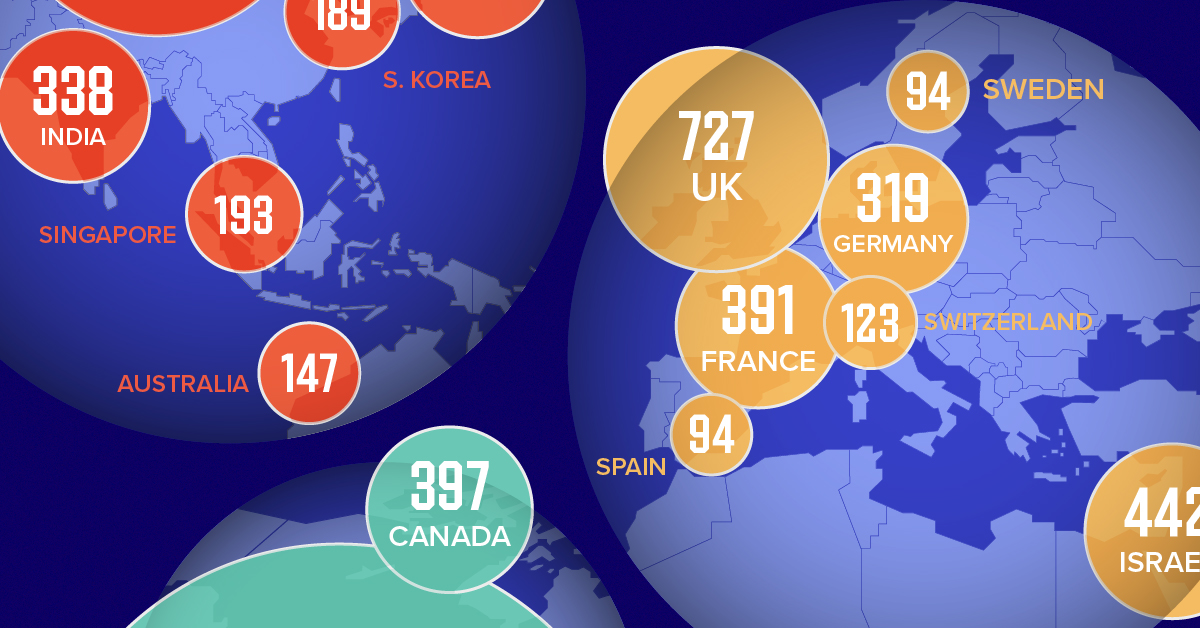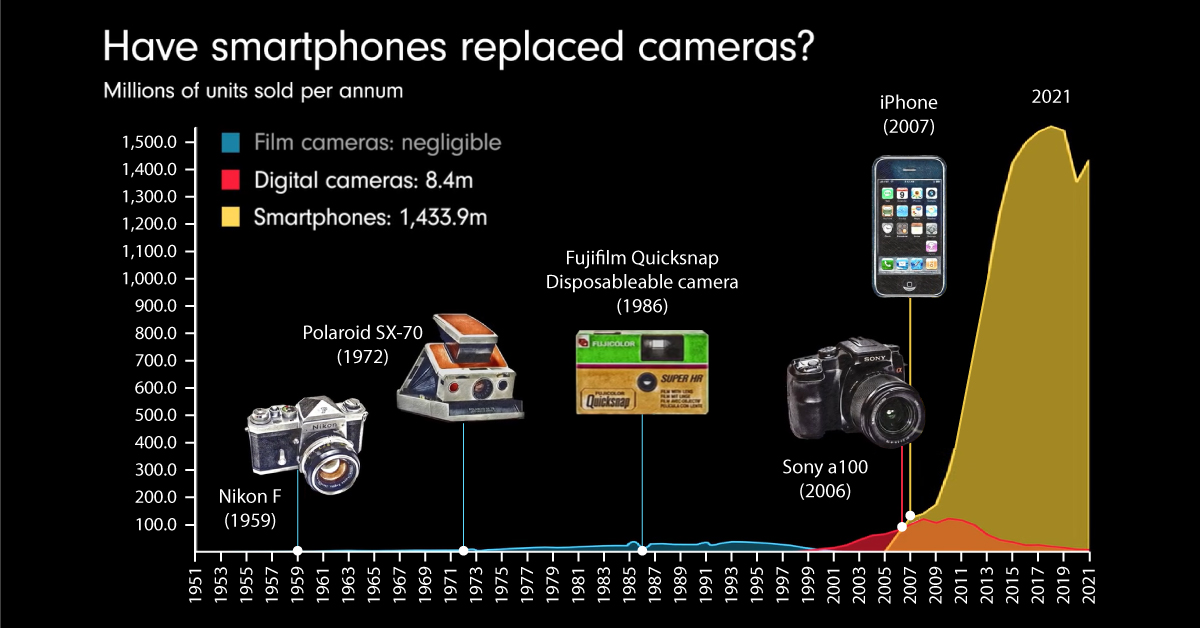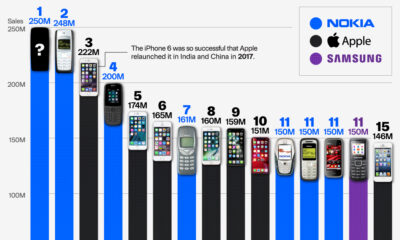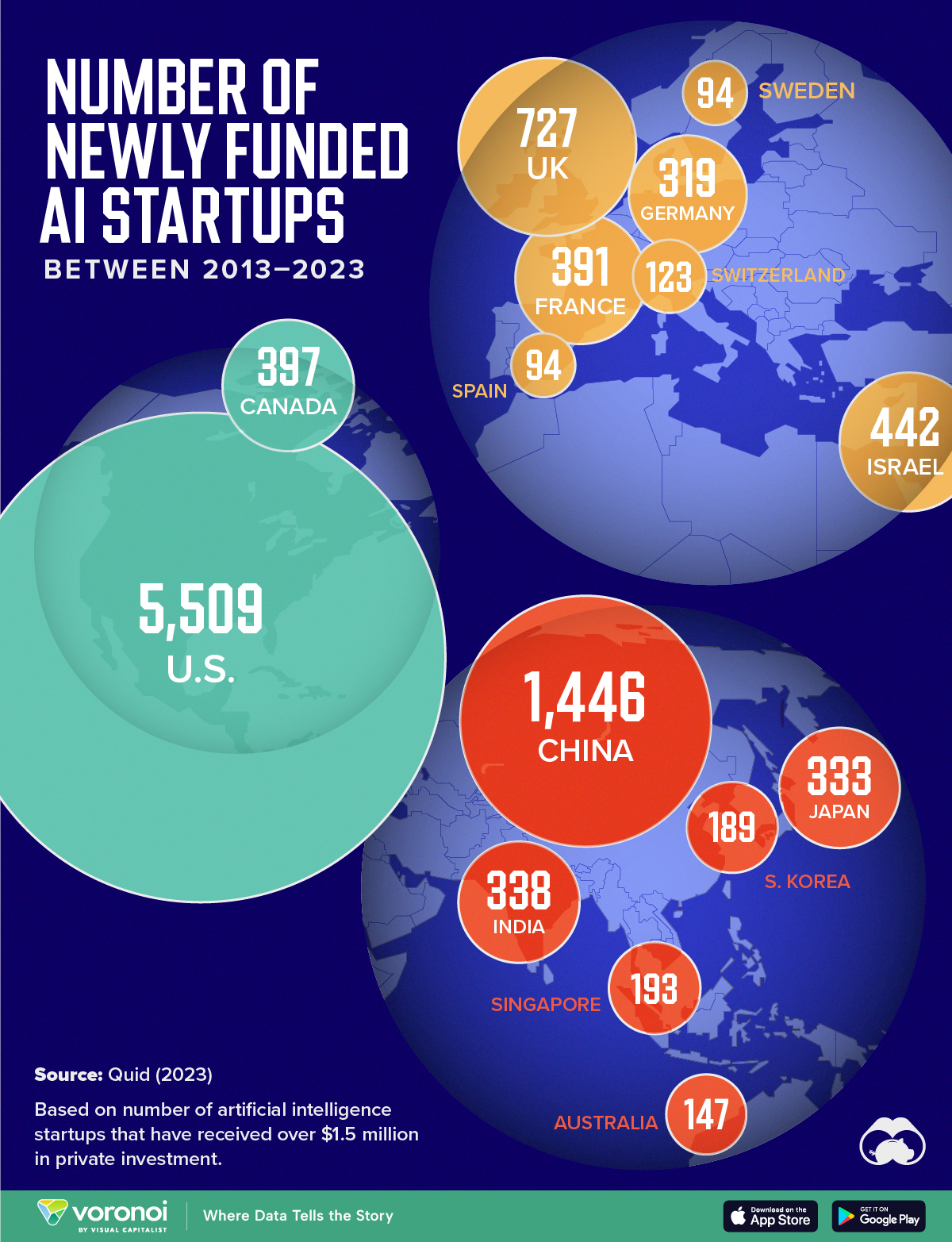Technology
Animated Chart: The Smartphone Effect on the Camera Market
Charting the Smartphone Effect on the Camera Market
The smartphone camera has come a long way since the early 2000s, and its impact on the overall camera market cannot be understated.
In fact, modern smartphones have become so sophisticated that the CEO of Sony’s semiconductor manufacturing company predicts that smartphone cameras will soon produce better quality images than DSLR cameras.
Whether smartphones will be able to completely replace standalone cameras is still a contentious debate topic, but one thing is clear—while smartphone sales have skyrocketed over the last decade, digital camera sales have plummeted.
This animation by James Eagle compares annual sales data for film cameras, digital cameras, and smartphones over the years to show just how much smartphones have impacted the camera market.
A (Brief) History of Standalone Cameras
Below, we’ve broken down the history of cameras into three overarching periods: early cameras, film cameras, and digital cameras.
Early Cameras
Cameras have been around for thousands of years, with descriptions of camera-like devices found in historical writings dating back as far as the 4th century:
- 330 AD: Ancient Chinese texts describe a device known as a camera obscura. Similar to pinhole cameras, these didn’t produce actual photographs, but rather reflected light onto screens which could then be traced to produce a lasting image.
- Early 1800s: It’s generally accepted that Joseph Nicéphore Niépce invented the first photographic camera in 1816. Using silver chloride, Niépce managed to develop an image that’s still around today.
- 1840s: Early cameras produced negative images which had to be color corrected, until mirrored cameras were invented. Alexander S. Wolcott was the first person to patent a mirrored camera in 1840.
- 1871: Richard Leach Maddox came up with an invention that led to instantaneous exposure, meaning cameras only needed to be exposed to light for a few seconds before producing an image.
These early inventions were critical milestones in the development of the modern-day camera. However, cameras and film weren’t available to the masses until Kodak’s Brownie camera made photography relatively cheap.
The Emergence of Film Cameras
Released in 1900, the Kodak Brownie was a handheld, inexpensive roll film camera invented by George Eastman.
When it first launched, the camera sold for $1.00, equivalent to about $35.48 in 2022 dollars. With more than 100,000 cameras sold within the first year, Eastman is often credited for making photography accessible to the masses.
Fast forward a few decades, and technological advancements led to features in cameras like viewfinders, different shutter speeds, and detachable lenses. These features were possible on what’s known as twin lens reflex cameras, or TLR for short, but they were soon replaced by single lens reflex cameras (SLR).
Digital Cameras Enter the Scene
By the late 1990s, digital cameras were invented and began quickly outselling film cameras.
Unlike their film counterparts, digital cameras feature a digital sensor, and store images on a memory card which could store thousands of pictures.
Digital camera sales grew throughout the early 2000s—in 2005 the Photo Marketing Association International even estimated that 52% of households would own a digital camera by the end of the year.
The Smartphone Camera Changes the Game
In the early 2000s, camera phones were far less powerful than their standalone counterparts.
For instance, one of the first camera phones to hit the market, Samsung’s SCH-V200, could take 20 pictures at 0.35-megapixel resolution. In contrast, Canon’s EOS D30 digital camera released the same year had a resolution of 3 megapixels.
But the advent of the iPhone, and the rollout and accessibility of modern smartphones with powerful cameras, quickly saw many non-enthusiasts switch to smartphone cameras only. In 2022, Google’s Pixel 7 has multiple built-in cameras, with both a 50 megapixel wide rear camera and a 12 megapixel ultrawide rear camera. In comparison, Canon’s enthusiast EOS 850 has a 24.1 megapixel sensor.
The animated chart above highlights the direct impact on the digital camera market after its 2009/2010 peak:
| Year | Digital Camera Sales |
|---|---|
| 1999 | 10.2 million |
| 2009 | 121.2 million |
| 2021 | 8.4 million |
So does that make a modern smartphone camera better? Not at all, as there are other a multitude of factors to consider when assessing a camera’s quality besides resolution. But in an article in Wired Magazine, tech journalist Sam Kieldsen explains how the market has shifted:
[Smartphones have] effectively killed off the cheap pocket point-and-shoot camera already, but there’s still so much they can’t do in comparison to a true purpose-built mirrorless or DSLR camera. Low light image quality, convincing bokeh effects and extreme close-up macro photography are all still significantly better on a real camera.
Smartphones may not be fully replacing DSLR cameras anytime soon, but they’ve certainly changed the industry and game in which it plays.

This article was published as a part of Visual Capitalist's Creator Program, which features data-driven visuals from some of our favorite Creators around the world.
Digital Transformation
Mapped: The Number of AI Startups By Country
Over the past decade, thousands of AI startups have been funded worldwide. See which countries are leading the charge in this map graphic.

Mapped: The Number of AI Startups By Country
This was originally posted on our Voronoi app. Download the app for free on iOS or Android and discover incredible data-driven charts from a variety of trusted sources.
Amidst the recent expansion of artificial intelligence (AI), we’ve visualized data from Quid (accessed via Stanford’s 2024 AI Index Report) to highlight the top 15 countries which have seen the most AI startup activity over the past decade.
The figures in this graphic represent the number of newly funded AI startups within that country, in the time period of 2013 to 2023. Only companies that received over $1.5 million in private investment were considered.
Data and Highlights
The following table lists all of the numbers featured in the above graphic.
| Rank | Geographic area | Number of newly funded AI startups (2013-2023) |
|---|---|---|
| 1 | 🇺🇸 United States | 5,509 |
| 2 | 🇨🇳 China | 1,446 |
| 3 | 🇬🇧 United Kingdom | 727 |
| 4 | 🇮🇱 Israel | 442 |
| 5 | 🇨🇦 Canada | 397 |
| 6 | 🇫🇷 France | 391 |
| 7 | 🇮🇳 India | 338 |
| 8 | 🇯🇵 Japan | 333 |
| 9 | 🇩🇪 Germany | 319 |
| 10 | 🇸🇬 Singapore | 193 |
| 11 | 🇰🇷 South Korea | 189 |
| 12 | 🇦🇺 Australia | 147 |
| 13 | 🇨🇭 Switzerland | 123 |
| 14 | 🇸🇪 Sweden | 94 |
| 15 | 🇪🇸 Spain | 94 |
From this data, we can see that the U.S., China, and UK have established themselves as major hotbeds for AI innovation.
In terms of funding, the U.S. is massively ahead, with private AI investment totaling $335 billion between 2013 to 2023. AI startups in China raised $104 billion over the same timeframe, while those in the UK raised $22 billion.
Further analysis reveals that the U.S. is widening this gap even more. In 2023, for example, private investment in the U.S. grew by 22% from 2022 levels. Meanwhile, investment fell in China (-44%) and the UK (-14.1%) over the same time span.
Where is All This Money Flowing To?
Quid also breaks down total private AI investment by focus area, providing insight into which sectors are receiving the most funding.
| Focus Area | Global Investment in 2023 (USD billions) |
|---|---|
| 🤖 AI infrastructure, research, and governance | $18.3 |
| 🗣️ Natural language processing | $8.1 |
| 📊 Data management | $5.5 |
| ⚕️ Healthcare | $4.2 |
| 🚗 Autonomous vehicles | $2.7 |
| 💰 Fintech | $2.1 |
| ⚛️ Quantum computing | $2.0 |
| 🔌 Semiconductor | $1.7 |
| ⚡ Energy, oil, and gas | $1.5 |
| 🎨 Creative content | $1.3 |
| 📚 Education | $1.2 |
| 📈 Marketing | $1.1 |
| 🛸 Drones | $1.0 |
| 🔒 Cybersecurity | $0.9 |
| 🏭 Manufacturing | $0.9 |
| 🛒 Retail | $0.7 |
| 🕶️ AR/VR | $0.7 |
| 🛡️ Insurtech | $0.6 |
| 🎬 Entertainment | $0.5 |
| 💼 VC | $0.5 |
| 🌾 Agritech | $0.5 |
| ⚖️ Legal tech | $0.4 |
| 👤 Facial recognition | $0.3 |
| 🌐 Geospatial | $0.2 |
| 💪 Fitness and wellness | $0.2 |
Attracting the most money is AI infrastructure, research, and governance, which refers to startups that are building AI applications (like OpenAI’s ChatGPT).
The second biggest focus area is natural language processing (NLP), which is a type of AI that enables computers to understand and interpret human language. This technology has numerous use cases for businesses, particularly in financial services, where NLP can power customer support chatbots and automated wealth advisors.
With $8 billion invested into NLP-focused startups during 2023, investors appear keenly aware of this technology’s transformative potential.
Learn More About AI From Visual Capitalist
If you enjoyed this graphic, be sure to check out Visualizing AI Patents by Country.
-

 Energy6 days ago
Energy6 days agoMapped: The Age of Energy Projects in Interconnection Queues, by State
-

 AI2 weeks ago
AI2 weeks agoVisualizing AI Patents by Country
-

 Markets2 weeks ago
Markets2 weeks agoEconomic Growth Forecasts for G7 and BRICS Countries in 2024
-

 Wealth2 weeks ago
Wealth2 weeks agoCharted: Which City Has the Most Billionaires in 2024?
-

 Technology2 weeks ago
Technology2 weeks agoAll of the Grants Given by the U.S. CHIPS Act
-

 Green1 week ago
Green1 week agoThe Carbon Footprint of Major Travel Methods
-

 United States1 week ago
United States1 week agoVisualizing the Most Common Pets in the U.S.
-

 Culture1 week ago
Culture1 week agoThe World’s Top Media Franchises by All-Time Revenue















